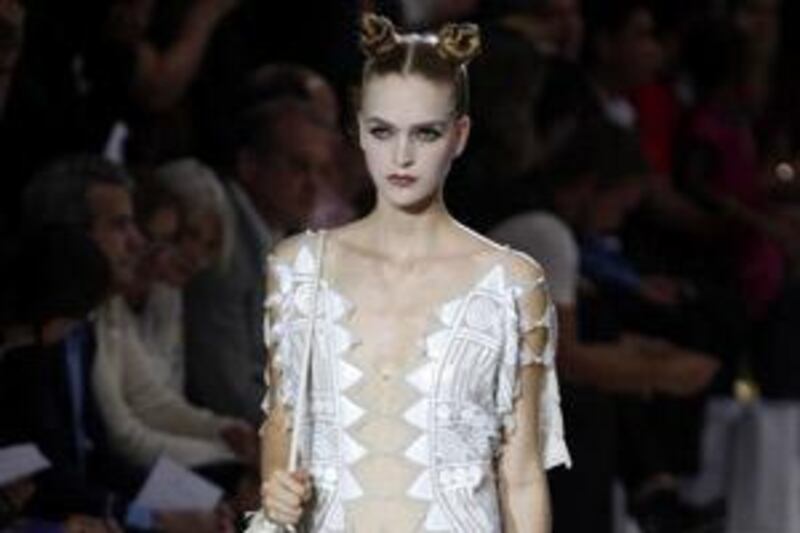In fashion, there's always been a battle between wearability and artistry. But with the recession crimping consumer budgets and crippling the credit markets, designers have been a little conservative this week, knowing that the recessionary demands call for wearable clothes that will move in stores. But Marc Jacobs, a man who has achieved commercial success for his eponymous line as well as for Louis Vuitton, where he serves as creative director, seemed to disregard the market in his spring/summer 2010 collection. Ever the rebel, he sent down a madcap array of pieces that eccentric women, such as the fashionably brave pop star Lady Gaga (who was in attendance), would wear. The collection may be a little inaccessible to some, but it was filled with wondrous shapes, textures, layers and colours that seemed to be derived from the brave get-ups of Japan's Harajuku girls. Despite the inherent risk, this bold collection reminded us that fashion is all about having fun. Jacobs opened with a pale pink, Comme des Garçons-esque number that was partly a button-down shirt, and white, short, lace cocktail frocks with lace panels and pearls randomly strewn about. If this appeared like the nightmare bridesmaid dresses that girls stay away from in romantic comedy movies, then Jacobs redeemed himself with the last number: a delicate-looking dress consisting of layers of sheer chiffon, which had black edges creating a series of sinewy contour lines all over the model's body.
If Jacobs upped the ante for American sportswear, Brian Reyes toned down the primness of his designs for the ladies-who-lunch set. The collection showed off a plethora of separates that a polished lady can choose from, such as easy and light tunic tops, jeans shorts and skirts with origami pleating (the most interesting treatment of denim this season), and a see-through black georgette top with geometric seams and white appliqué resembling a Rorschach inkblot. This graphic effect also found its way on to a white georgette top with a burnt-out effect and a black sheath dress that ended Reyes' enthusiastic and retail-friendly showing.
Perhaps anticipating that consumers won't be as inclined towards his va-va-voom frocks, Carlos Miele also focused on pieces that his customers can mix and match with their existing clothes. Miele offered options to inject his brand of hot glamour into any wardrobe without forcing the purchase of his more expensive bright dresses with chiffon overlays and animal-print floor-length gowns with plunging necklines. Instead, women can lift their looks with nude silk chiffon blouses with faint and abstract prints and embroidered tops with a cracked texture.
Jill Stuart also opted out of the frilly girlishness that her brand has come to be synonymous with. This season she veered towards a harder look, with cotton and silk dresses accessorised by otherworldly screen boots (a look reminiscent of Balenciaga's futuristic spring 2007 collection), metallic studs on pencil skirts, leggings with sharp cuts revealing the legs, and an amalgamation of fabric with a shiny scarab surface and stretchy lace.
Bibhu Mohapatra, an Indian designer, meticulously constructed a series of square panels of colour on a silk dress, an organza layer over an abstract printed top, and a white and yellow gown that had several textures created with layers, panels and ruching of silk. Mohapatra's unexpected mix of textures and experimentation drew applause, but at times felt very heavy. Carolina Herrera, too, seemed to be feeling a little aesthetically adventurous. This go-to designer for Renée Zellweger and other consistent red-carpet gems chose to make clothes inspired by Japanese basket weaves this season. Although the first look's woven style created an interesting see-through effect, the way Herrera used the technique in the rest of the collection didn't feel quite as light. But, of course, there were also those bankable red-carpet knockouts such as a risque metallic purple floor-length number that Zellwegger and her A-list friends will surely want.
Staying true to the arty romanticism that she's known for, Vera Wang served up a darker collection, showcasing her dressmaking sills by mixing different textures. There was a dramatic floor-length gown with crinkly vintage tulle, a marabou bolero with origami pleated shifts, and a sequinned pencil skirt underneath an organza sheath. Wang toned down the layers and the fabric manipulation that appeared overwrought in seasons past, but will still achieve kudos from discerning women who appreciate workmanship.
The French born, Brooklyn-based Sophie Theallet has been working under the radar for many years, but ever since the US first lady Michelle Obama wore her skirt earlier this year, her fame has skyrocketed. For a designer who focuses on utterly feminine clothes that can last through the years, the CFDA Fashion Fund nominee showed that her work isn't suffering from all the attention. Theallet reworked a transparent nightie into a chic day dress, nude chiffon was overlaid in a cotton dress with prints (an effect she's been using for the past couple of seasons), and chic skirts that moved as light as a feather. Theallet doesn't try too hard or force a mission to change silhouettes, but instead offers feminine clothes that will make any woman in any era look utterly chic.










